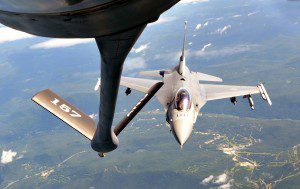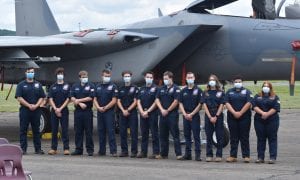
A F-16 pilot lines up on the Boeing KC-135 Stratotanker during yesterday’s midair refueling exercise in northern New England. (Photo by chief photographer Frederick Gore)
WESTFIELD – Some drivers have trouble pulling up to a gas pump, so imagine the skill it takes to fuel an F-15C Eagle in flight while traveling above the clouds at 480 knots.
That’s just what members of the 104th Fighter Wing at Barnes Air National Guard Base did yesterday during a training exercise above northern New England.
Major Matthew T. Mutti, wing executive staff officer with the 104th, said yesterday’s exercise involved two of the wing’s F-15s engaged in “dogfight” training.
“One takes on the role of the aggressor and the other takes the part of the adversary,” said Mutti.
Each F-15 carries up to 48,000 pounds of jet fuel, said Mutti, which last up to 90 minutes. During the exercise, the pilots refueled with the New Hampshire Air National Guard’s 157th Air Refueling Wing that is based at Pease Air National Guard Base located at Portsmouth International Airport New Hampshire.
In order to refuel, the F-15 pilot lines up behind the KC-135 Stratotanker refueling aircraft, and connects to it through a gas tube.
“It pumps gas directly into the F-15,” said Mutti. “It takes about 20 minutes to fuel four F-15s.”
Mutti said the refueling is part of the exercise for both wings.
“We have the alert responsibility for defense, while Pease has the alert responsibility for refueling,” he said.
During yesterday’s exercise, the 157th also refueled the Vermont Air National Guard’s F-16s.
Mutti said while the Stratotanker cannot get in the air as quickly as an F-15, when the 104th is scrambled, the 157th is right behind them.
“The KC-135 is an older refueler from the 70’s and holds about 83,000 pounds of cargo – in this case, fuel,” said Mutti. “Fully fueled, it weighs about 322,000 pounds.”
Mutti said on a clear day like yesterday, refueling in the air is a difficult task, but it is easier than when there is inclement weather, or at night.
“It gets exponentially more difficult in the dark,” Mutti said.
A crew of four staffs the Stratotanker, including a pilot and boom operator.
The KC-135 was the US Air Force’s first jet-powered refueling tanker and replaced the KC-97 Stratotanker. The Stratotanker was initially tasked to refuel strategic bombers, but was used extensively in the Vietnam War and later conflicts, such as Operation Desert Storm, to extend the range and endurance of US tactical fighters and bombers.
Serving with the United States Air Force since 1957, it is one of just six military fixed-wing aircraft with over 50 years of continuous service with its original operator.
The McDonnell Douglas (now Boeing) F-15 Eagle is a twin-engine all-weather tactical fighter to gain and maintain air superiority in aerial combat. It is considered among the most successful modern fighters, with over 100 aerial combat victories with no losses in dogfights.
The Eagle first flew in July 1972, and entered service in 1976. The F-15 is expected to be in service with the U.S. Air Force past 2025.
The 104th has been flying F-15Cs since September, 2007. Prior to that, the 104th flew A-10 Warthogs.
To see video of a jet fighter refueling in mid-air, click here.







